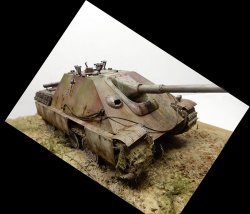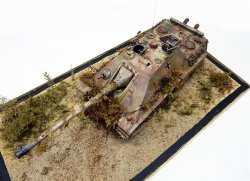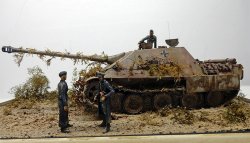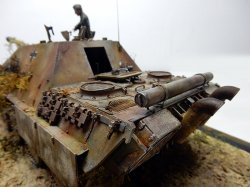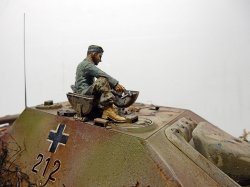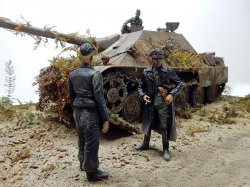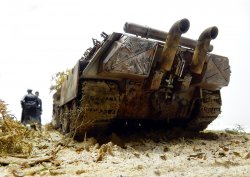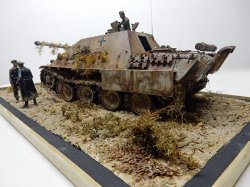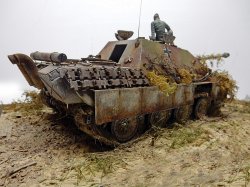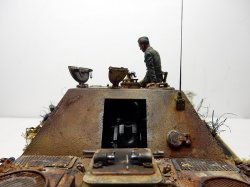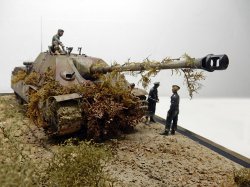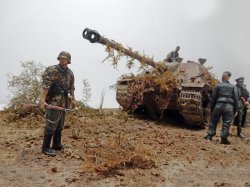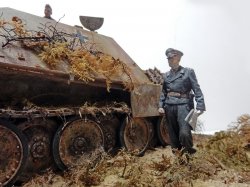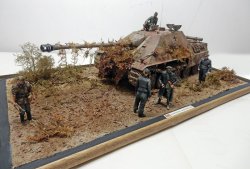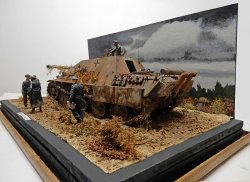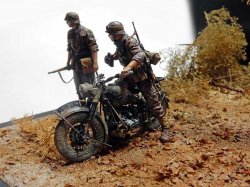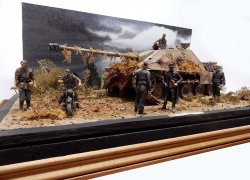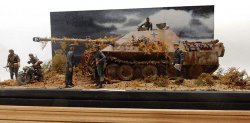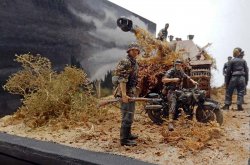
Galerie * Gallery - Jagdpanther - Normandie 1944 - échelle 1/24ème
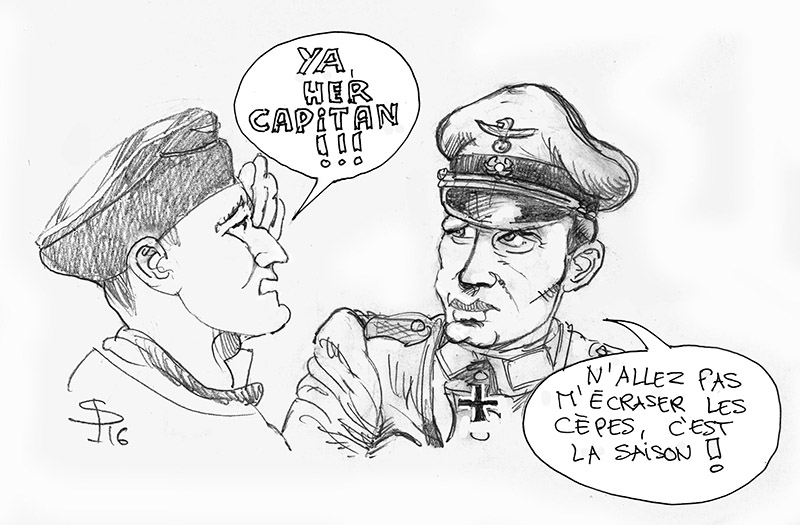
"Don't go crushing my porcini mushrooms, it's in season !"
JAGDPANTHER - Sdkfz 173
Un des plus « beaux » engins de combat de la seconde guerre mondiale…
En août 1942, le haut commandement allemand décide d’adapter l’excellent canon de 8,8 cm Pak 43 sur un chassis de Panther alors actuellement en vigueur sur le Nashorn – automoteur d’artillerie découvert sur chassis de Panzer IV.
Démarré chez Krupp en octobre 1942, le projet part chez Daimler-Benz qui fabriquera le Panther à partir de l’été 1943…
Equipage de 5 hommes – 9,96m de long – 3,42m de large – 2,71m de haut pour un poids de 46T. Le moteur Maybach HL230-P30 assure une vitesse de 55km/h.
57 obus – une mitrailleuse en casemate MG34 – 1 lance grenade.
1 viseur périscopique Sfl Z1A pour le pointeur – 2 pour le pourvoyeur – 1 Sf1 4Z pour le chef de char.
Les postes de radio sont les FU 15 & FU16 utilisés par l’artillerie. Les engins de commandement seront équipés de FU 8 à longue portée.
…En mai 1943 la production passe chez MIAG – Daimler rencontrant des problèmes dont de place… A la fin du mois, le blindage du toit, glacis et plage arrière passe à 16mm pour alléger le véhicule (le frontal reste de 100 à 60mm)…
Le canon est légèrement décalé vers la droite réduisant le débattement de 12° horizontalement de chaque côté. Les fins de série (septembre 44) bénéficieront d’un mantelet boulonné pour faciliter le démontage du canon.
La pose de zimmerit est également arrêtée en septembre 1944 sur tous les véhicules.
Le 1er prototype sort en octobre 1943. La version finale en décembre 1944 avec réagencement de l’outillage à l’arrière, pots d’échappement réduisant les émissions de flammes, ventilateur arrière rehaussé pour le chauffage du compartiment de l’équipage.
La production débute de janvier 1944 jusqu’en avril 1945… Mais là encore… Tout est relatif… La revue Steelmasters – pour ne pas la citer – donne des chiffres différents dans son n°9 et le thématique n°2… Où l’on passe de 415… à … 72 !!! Choisissez !
*****
Un membre de famille m’a raconté – il y a déjà bien longtemps – sa rencontre avec un Jagdpanther alors qu’il commandait des Sherman dans le bocage normand. Bien dissimulé dans les fourrés, il prit pour cible la colonne, détruisant un char après l’autre… Ils ne durent leur salut qu’en réussissant à le contourner et détruisant une chenille pour l’immobiliser…
La deuxième guerre mondiale est sans contexte le plus grand conflit que l’humanité est connu, mobilisant plus de 100 millions de combattants en tuant environ 60 millions dont une majorité de civils.
Ce fut la plus grande guerre idéologique de l’histoire.
La somme des dégâts n’a jamais pu être chiffrée de façon certaine, mais il est à peu près sûr qu’elle dépasse l’ensemble des conflits du genre humain depuis son apparition…
JAGDPANTHER - Sdkfz 173
One of the most "beautiful" fighting machines of the Second World War...
In August 1942, the German High Command decided to adapt the excellent 8.8 cm Pak 43 cannon to a Panther chassis, then in use on the Nashorn - a self-propelled artillery vehicle built on a Panzer IV chassis.
Begun at Krupp in October 1942, the project was then transferred to Daimler-Benz, who manufactured the Panther from summer 1943...
Crew of 5 men - 9.96m long - 3.42m wide - 2.71m high for a weight of 46T. The Maybach HL230-P30 engine ensures a speed of 55km/h.
57 shells - one MG34 casemate machine gun - 1 grenade launcher.
1 Sfl Z1A periscope sight for the aimer - 2 for the outfitter - 1 Sf1 4Z for the tank commander.
Radio sets are the FU 15 & FU16 used by the artillery. Command vehicles are equipped with long-range FU 8s.
...In May 1943, production shifted to MIAG - Daimler encountered space problems... At the end of the month, roof, glacis and rear deck armor were reduced to 16mm to lighten the vehicle (the front end remained at 100-60mm)...
The barrel is shifted slightly to the right, reducing the horizontal travel by 12° on each side. End-of-series models (September 44) will benefit from a bolted shackle to facilitate barrel removal.
Zimmerit fitting was also discontinued on all vehicles in September 1944.
The 1st prototype came out in October 1943. The final version in December 1944, with rearranged rear tooling, flame-reducing exhaust pipes and a raised rear fan to heat the crew compartment.
Production runs from January 1944 to April 1945... But then again... It's all relative... Steelmasters magazine - not to quote it - gives different figures in its n°9 and the thematic n°2... Where we go from 415... to ... 72 !!! Take your pick!
*****
A family member told me - a long time ago - of his encounter with a Jagdpanther while commanding Shermans in the Normandy bocage. Well concealed in the thicket, it targeted the column, destroying one tank after another... They only saved themselves by managing to get around it and destroying a caterpillar to immobilize it...
The Second World War was without doubt the greatest conflict known to mankind, mobilizing over 100 million combatants and killing around 60 million, the majority of them civilians.
It was the greatest ideological war in history.
The sum total of the damage has never been quantified with any certainty, but it's fairly certain that it exceeds the sum total of all human conflicts since its inception...















